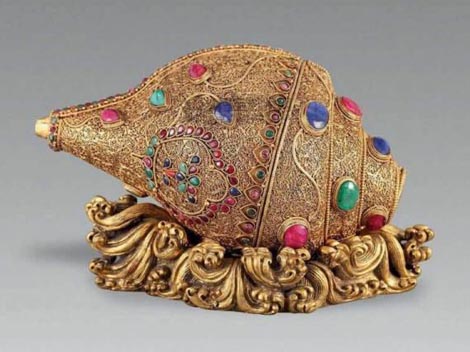
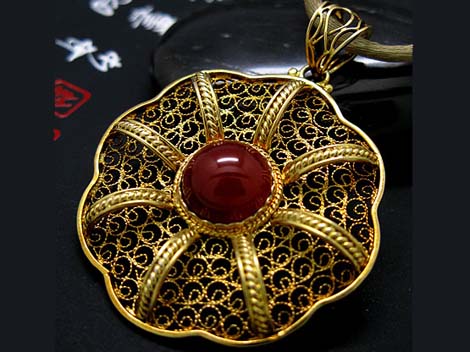
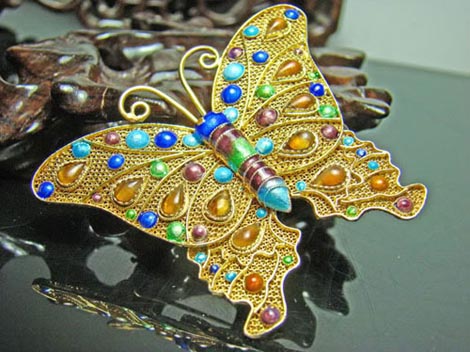
Filigree inlaid metal art is one of the eight traditional arts and crafts of Beijing. Use of the filigree-inlay process began during the Spring and Autumn Period (770-476BC), and the process flourished during the Ming Dynasty (1368-1644). The process was first documented during the Tang Dynasty (618-907). As most filigree-inlaid items are made from gold, they tend to be precious. For centuries, only members of China's royal family could enjoy works of filigree inlaid art.
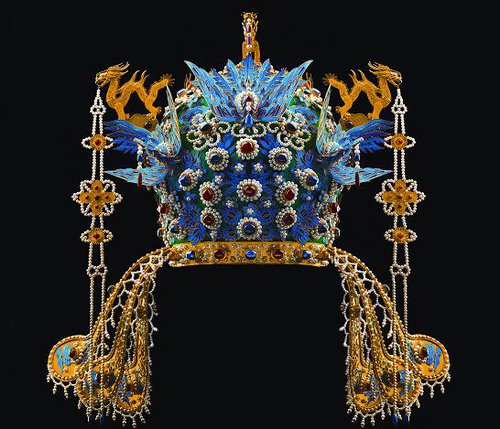
A filigree inlaid metal art work [Provided by Zhaoyi Jade]
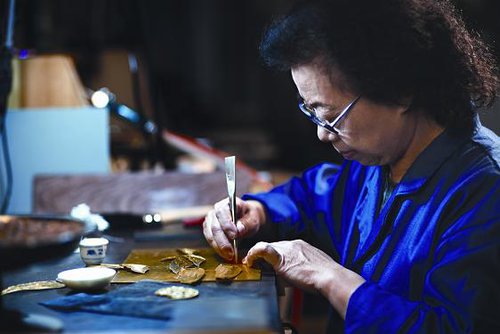
A woman makes a filigree inlaid metal art work. [Provided by Zhaoyi Jade]
Nowadays, filigree inlaid metal art gradually becomes popular in China. Let's have a look at how it is made. It is made from gold, silver or other materials. The craftsmen create metal art works from thin strips of gold or silver through piling and weaving. Then the gold and silver strips are hammered into already crafted metal ware. The metal ware is then decorated with carved patterns and inlaid with precious materials such as gems, pearls and woven patterns.
Crafts from Royal Court
During the Spring and Autumn Period (770-476 BC), metal ware began to use the techniques involved in filigree inlays. Filigree- inlaid metal art flourished in the Ming Dynasty (1368-1644) and made great progress during the Qing Dynasty (1644-1911).
In 1958, a gold crown was discovered at Ding Mausoleum, which had 13 royal tombs from the Ming Dynasty. The crown was made of 518 extremely thin gold threads, each about 0.2 centimeter in diameter. Two dragons, each playing with a pearl, were carved on the crown.
"Huasi Xiangqian," or filigree inlay, was the technology used to make the crown. Many works of filigree-inlaid art were given as tributes to the imperial court.
Over the time, filigree inlay has developed into a valued and cherished folk art in China.
More than one hundred filigree workshops existed in Beijing in 1980s. Unfortunately, the opening of the gold markets in the 1990s became a nightmare for many filigree workshops. Only a few workshops specializing in hand made filigree inlaid works survived.
Beijing and Chengdu, a city in southwestern China, are both well-known for their exquisite filigree-inlaid art. But they boast of different characteristics. Beijing filigree-inlaid works are famous for its perfect weaving and piling craftsmanship. Beijing filigreed-inlaid craftworks have received high accolades from around the world and were awarded the Excellent Design Award at a Southeastern Asian Jewelry Design Contest. Chengdu filigree inlaid metal ware includes mainly silver filigree works in the form of vases, compotes and jewelry.
Revival and Breakthrough
In 1958, Beijing Filigree Inlaid Factory was founded. At that time, the factory employed more than 1,000 people. By the end of the 1980s, the factory was in financial trouble, as exports of filigree-inlaid works dropped off. In 2002, the factory declared bankruptcy. Many of the craftsmen left the factory to find new jobs. In 2008, filigree-inlaid art was listed as an intangible cultural heritage of China. That began the revival of the ancient handicraft.
Bai Jingyi, who was born in 1942, became the representative inheritor of filigree-inlaid art. In 1961, Bai graduated from Beijing Crafts and Arts School with a major in metal arts. After she graduated, she went to work at Beijing Research Institute of Crafts and Arts, where she worked with many craftsmen to design filigree-inlaid art.
In 1963, she joined Beijing Filigree Inlaid Factory, where she worked until her retirement in 2002.
At the factory, many famous masters, including Zhai Deshou and Wu Kenan, taught her about the craft. Bai has since designed many filigree-inlaid masterpieces. One of her works earned her the highly prestigious Excellent Design Award at the 1983 Southeastern Asian Jewelry Design Contest.
"There are 56 ethnic groups in China. The jewelry of each ethnic group has its own characteristics. In addition, there is much jewelry that has been passed down from ancient times. That jewelry still looks fashionable in the eyes of modern men. We can learn a lot from those works,'' says Bai.
In 2009, Bai entered into a strategic business arrangement with Zhaoyi Jewelry Company and a year later, after six months of preparations, she opened her workshop in Beijing's Song Village. In November 2010, Zhaoyi Jewelry launched its custom-jewelry service, through which it has provided filigree-inlaid jewelry with emeralds to its customers. In the past three years, Bai has read many documents and visited many museums. With several of her colleagues, Bai has made replicas of gold crowns and various items of jewelry that reflect the lifestyle of China's royal families.
"Jewelry designs know no boundaries, but the designs should possess the traditions and culture of its nation. A good design should reflect the designer's wisdom and ideas. The best design can reflect both Eastern and Western culture," Bai says.





